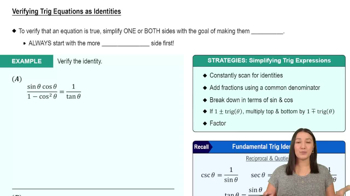Table of contents
- 0. Functions7h 52m
- Introduction to Functions16m
- Piecewise Functions10m
- Properties of Functions9m
- Common Functions1h 8m
- Transformations5m
- Combining Functions27m
- Exponent rules32m
- Exponential Functions28m
- Logarithmic Functions24m
- Properties of Logarithms34m
- Exponential & Logarithmic Equations35m
- Introduction to Trigonometric Functions38m
- Graphs of Trigonometric Functions44m
- Trigonometric Identities47m
- Inverse Trigonometric Functions48m
- 1. Limits and Continuity2h 2m
- 2. Intro to Derivatives1h 33m
- 3. Techniques of Differentiation3h 18m
- 4. Applications of Derivatives2h 38m
- 5. Graphical Applications of Derivatives6h 2m
- 6. Derivatives of Inverse, Exponential, & Logarithmic Functions2h 37m
- 7. Antiderivatives & Indefinite Integrals1h 26m
- 8. Definite Integrals4h 44m
- 9. Graphical Applications of Integrals2h 27m
- 10. Physics Applications of Integrals 2h 22m
3. Techniques of Differentiation
Derivatives of Trig Functions
Problem 3.5.80
Textbook Question
Using identities Use the identity sin 2x=2 sin x cos x sin 2 to find d/dx (sin 2x). Then use the identity cos 2x = cos² x−sin² x to express the derivative of sin 2x in terms of cos 2x.
 Verified step by step guidance
Verified step by step guidance1
Start by using the identity \( \sin 2x = 2 \sin x \cos x \). This identity helps us express \( \sin 2x \) in terms of \( \sin x \) and \( \cos x \).
Differentiate \( \sin 2x = 2 \sin x \cos x \) with respect to \( x \). Use the product rule for differentiation, which states that \( \frac{d}{dx}(u \cdot v) = u'v + uv' \). Here, \( u = \sin x \) and \( v = \cos x \).
Apply the product rule: \( \frac{d}{dx}(2 \sin x \cos x) = 2(\cos x \cdot \cos x + \sin x \cdot (-\sin x)) \). Simplify this expression to find \( \frac{d}{dx}(\sin 2x) \).
Now, use the identity \( \cos 2x = \cos^2 x - \sin^2 x \) to express \( \cos^2 x \) and \( \sin^2 x \) in terms of \( \cos 2x \). Substitute these into the derivative expression obtained in the previous step.
Simplify the expression to express \( \frac{d}{dx}(\sin 2x) \) in terms of \( \cos 2x \). This involves algebraic manipulation using the identity \( \cos 2x = \cos^2 x - \sin^2 x \).
 Verified video answer for a similar problem:
Verified video answer for a similar problem:This video solution was recommended by our tutors as helpful for the problem above
Video duration:
4mPlay a video:
Was this helpful?
Key Concepts
Here are the essential concepts you must grasp in order to answer the question correctly.
Trigonometric Identities
Trigonometric identities are equations that involve trigonometric functions and are true for all values of the variables involved. They are essential for simplifying expressions and solving equations in calculus. The identities sin 2x = 2 sin x cos x and cos 2x = cos² x - sin² x are examples that help relate different trigonometric functions, making it easier to differentiate or integrate them.
Recommended video:

Verifying Trig Equations as Identities
Differentiation
Differentiation is a fundamental concept in calculus that involves finding the derivative of a function, which represents the rate of change of the function with respect to its variable. In this context, we apply the chain rule and product rule to differentiate sin 2x using the identity provided. Understanding how to differentiate trigonometric functions is crucial for solving problems related to motion, optimization, and other applications.
Recommended video:

Finding Differentials
Chain Rule
The chain rule is a formula for computing the derivative of the composition of two or more functions. It states that if you have a function g(x) that is composed with another function f(x), the derivative is found by multiplying the derivative of f with respect to g by the derivative of g with respect to x. This rule is particularly useful when differentiating functions like sin(2x), where the inner function (2x) affects the outer function (sin).
Recommended video:

Intro to the Chain Rule

 3:53m
3:53mWatch next
Master Derivatives of Sine & Cosine with a bite sized video explanation from Callie
Start learning




